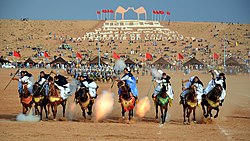
The culture of Mongolia has been shaped by the country's nomadic tradition and its position at the crossroads of various empires and civilizations. Mongolian culture is influenced by the cultures of the Mongolic, Turkic, and East Asian peoples, as well as by the country's geography and its history of political and economic interactions with other nations.
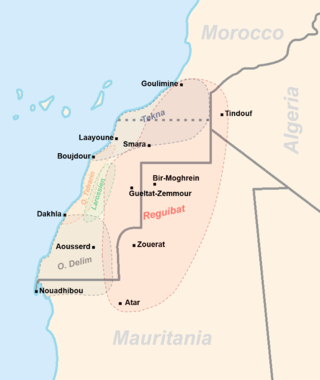
The Sahrawis, or Sahrawi people, are an ethnic group native to the western part of the Sahara desert, which includes the Western Sahara, southern Morocco, much of Mauritania, and along the southwestern border of Algeria. They are of mixed Hassani Arab and Sanhaji Berber descent, as well as West African and other indigenous populations.

Douz is a town in the Kebili Governorate in the south of Tunisia, known as the "gateway to the Sahara." By road it is located 31 kilometres (19 mi) southwest of Blidet, 125 kilometres (78 mi) southeast of Tozeur, and 475 kilometres (295 mi) south of the Tunisian capital of Tunis.
The Proclamation of Masterpieces of the Oral and Intangible Heritage of Humanity was made by the Director-General of UNESCO starting in 2001 to raise awareness of intangible cultural heritage and encourage local communities to protect them and the local people who sustain these forms of cultural expressions. Several manifestations of intangible heritage around the world were awarded the title of Masterpieces to recognize the value of the non-material component of culture, as well as entail the commitment of states to promote and safeguard the Masterpieces. Further proclamations occurred biennially. In 2008, the 90 previously proclaimed Masterpieces were incorporated into the new Representative List of the Intangible Cultural Heritage of Humanity as its first entries.
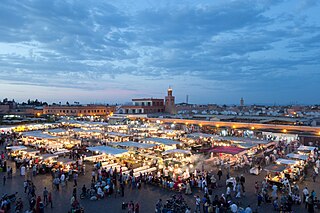
Jemaa el-Fnaa, also Jemaa el-Fna, Djema el-Fna or Djemaa el-Fnaa, is a square and market place in Marrakesh's medina quarter. It remains the main square of Marrakesh, used by locals and tourists.

The Regraga are a subgroup within the larger Masmuda Berber tribal confederacy of Morocco. They historically played a pivotal role in the cultural and religious landscape of the Chiadma region along the Atlantic coast, situated between Safi and Essaouira. The Regraga are noted for their spiritual practices and their annual pilgrimage, known locally as the Moussem, which spans 39 days and begins each year at the spring equinox.

The long song is one of the central elements of the traditional music of Mongolia. This genre is called "Long song" not only because the songs are long, but also because each syllable of text is extended for a long duration. A four-minute song may only consist of ten words. Certain long songs such as Uvgin shuvuu khoyor, also known as Jargaltain delger take up to three hours to sing at full length, with all thirty-two stanzas. Lyrical themes vary depending on context; they can be philosophical, religious, romantic, or celebratory, and often use horses as a symbol or theme repeated throughout the song. Eastern Mongols typically use a Morin khuur as accompaniment, sometimes with a type of indigenous flute, called limbe. Oirat groups of the Western Mongols traditionally sing long songs unaccompanied or accompanied with the Igil.
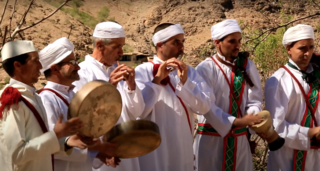
Aḥwash is a Shilha style of collective performance, including dance, singing, poetry and percussion, from southern Morocco. The ahwash is performed on the occasion of local festivals as a celebration of the community.

Fantasia is a traditional exhibition of horsemanship in the Maghreb performed during cultural festivals and for Maghrebi wedding celebrations. It is present in Algeria, Libya, Mali, Mauritania, Morocco, Niger and Tunisia. It is attested in the ancient Numidian times during which it was practiced by the Numidian cavalry. Historian Carlos Henriques Pereira stated that the North African fantasia also called barud is a modern watered down version of a Numidian military technique.
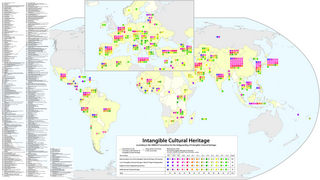
UNESCO established its Lists of Intangible Cultural Heritage with the aim of ensuring better protection of important intangible cultural heritages worldwide and the awareness of their significance. This list is published by the Intergovernmental Committee for the Safeguarding of Intangible Cultural Heritage, the members of which are elected by State Parties meeting in a General Assembly. Through a compendium of the different oral and intangible treasures of humankind worldwide, the programme aims to draw attention to the importance of safeguarding intangible heritage, which UNESCO has identified as an essential component and as a repository of cultural diversity and of creative expression.

Al-Sirah al-Hilaliyyah, also known as the Sirat Bani Hilal or the al-Hilali epic, is an Arabic epic oral poem that recounts the tale of the journey of the Bedouin tribe of the Banu Hilal from Najd in Arabia to Tunisia and Algeria via Egypt. It is built around historical events that took place in the 11th century. The Banu Hilal were dominant in central North Africa for over a century before their annihilation by the Almohads. The epic is folkloric and oral, not having been committed to writing until relatively recent times, and doesn't have a well-defined date of creation. Of the dozen odd major oral epic poems that developed within the Arab folk tradition between the Middle Ages and the 19th century, Sirat Bani Hilal is today the only one that is still performed in its integral musical form. The longest notable version contains 1,000,000 lines, the poet could sing this version about 100 hours. The epic, once widespread throughout the Middle East, is today performed only in Egypt. In 2008 it was inscribed on UNESCO's Representative List of the Intangible Cultural Heritage of Humanity.
The Folklore of Belgium is extremely diverse and reflects the rich legacy of cultural and religious influences which have acted on the region throughout its history, even before the establishment of the nation of Belgium in 1830. Much of Belgian folklore is unique to the region in which it is commemorated. Many aspects of folklore are manifested in public processions and parades in Belgian cities; traditions which are kept alive for the amusement of locals and tourists alike.

The Festivity of La Mare de Déu de la Salut is a festival celebrated in Algemesí (Valencia), Spain, from August 29 to September 8. The festival is in honour of the patron saint of Algemesí, La Mare de Déu de la Salut, and has been dated back to 1247. The holiday was awarded the UNESCO "Masterpieces of the Oral and Intangible Heritage of Humanity" designation on November 28, 2011.
Al Sadu, or simply Sadu, describes an embroidery form in geometrical shapes hand-woven by Bedouin people. Sadu House in Kuwait was established by the Al Sadu Society in 1980 to protect the interests of the Bedouins and Sadu weaving.
Mata is an equestrian game and performance performed by the Beni Arous tribe typically in May or June in the village of Znied, in the municipality of Larbaa Aicha, in the province of Larache, Morocco. The competition takes place in the hills upon the tomb of the Sufi saint Moulay Abdeslam ben Machich with over 200 participants. Over the course of three days, tribal teams on horses ride bareback and vie for control of a female puppet, which symbolizes the fertility of the spring season, and take it across the finish line. Women typically fashion the puppet out of tissue and traditional fabrics, making it smell of roses and drawing a face on the doll. Historically, the rider who brought the puppet across the finish line was given the hand of the most beautiful woman of the tribe. Today, the prize is money and prestige. The equestrian display is thought to represent the relationship between man and nature and man and horse. For male riders, it is a representation of their warrior prowess, but there is a single woman who participates in the practice. The practice is rumored to be a variation of the Afghan buzkashi game that the Moulay Abdeslam saw in Asia and brought to Morocco where it was integrated with local customs.

Mawsim or moussem, waada, or raqb, is the term used in the Maghreb to designate an annual regional festival in which worshippers usually combine the religious celebration of local Marabouts or Sufi Tariqas, with various festivities and commercial activities. These are very popular events, often attended by people from very distant places.

Sebiba is the term used in Algeria to designate a festival and the Tuareg people's dance performed on this occasion and accompanied by female drummers in the Sahara oasis of Djanet in the Tassili n'Ajjer region in southern Algeria. The dance originated among the descendants of black African slaves and is part of the celebrations for the Islamic Ashura Festival. The dance was recognized by UNESCO in 2014 for its significance to humanity's intangible cultural heritage.
